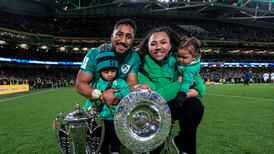If a cult of personality is essential for absolute rulers to maintain power then Sheikh Tamim bin Hamad al-Thani, the emir of Qatar, has nothing to fear. It is impossible to miss his image in Doha. He looks down at you as you queue at passport control, in the airport arrivals hall, and in the car park where his incised profile features on the back of the white 4x4s, Qatar's favourite mode of transport.
It is also on the sides of the five-star hotels, hung 100m high; on compound walls, in shopping malls, on T-shirts, flags and mugs. Wander through the souk, there is not an object too humble for the image of the emir.
The portrait of the chisel-jawed emir in his ghutra, or Arab headdress, was drawn by Qatari artist Ahmed bin Mahaed al-Maadheed, and is entitled "Glorious Tamim". Since the blockade imposed on the tiny, conservative, oil- and gas-rich country last June by Saudi Arabia the United Arab Emirates, Egypt and Bahrain, his drawing is seen everywhere. In schools, young children are encouraged to write supportive and patriotic comments on copies of the portrait affixed to school walls.
Qatar has the world’s highest per-capita GDP, and a vast amount of money is transferred to Qatari citizens, who number just 313,000, the remainder of the 2.3 million people being expatriates. Given Qatar’s wealth, there was little risk to the ruling family’s security, but if the motives of Saudi were to weaken the emir, that has not worked.
Patriotism outbreak
Recently there was an outbreak of patriotism in Doha, for national day. Throughout the day, children in military-style uniforms walked with their parents, their Filipino nannies walking behind, wearing badges showing the emir’s image. There was a military parade, the largest in the country’s history, and a massive firework display that could be seen from the Corniche.
Riyadh responded by closing the Abu Samrah border crossing. It had been left open to facilitate pilgrims travelling to Mecca for the Hajj. Now it is closed again and this time for good, seemingly.
The siege has meant prices have risen. Qatar Airlines has experienced difficulties, with longer flight times to Africa as the aircraft skirt Saudi airspace. It has lost 18 valuable destinations.
The desert country imported most basic goods through Saudi. Within hours of the siege milk disappeared, but the next day Turkish milk filled supermarket shelves. Now Qatar intends to be self-sufficient in dairy products and a giant farm has been built in the desert, where 5,000 cows live in giant sheds with massive air conditioning, without a blade of grass in sight. Phase two of the response is for 25,000 cows to be kept in pens in the massive sheds. It is surrounded by a sort of theme park of playgrounds, a zoo and large restaurants.
The reason for the crisis follows Saudi claims that Qatar supports terrorism, but actually is more about Qatar's relationship with Iran, Saudi's biggest regional rival and the focus of Saudi foreign policy.
Qatar’s neighbours issued 13 demands. None could realistically be acceded to; the Qatari foreign minister said to do so would be surrendering sovereignty. One demand was the shutting down of Qatar-funded broadcaster Al-Jazeera. The presence of Al-Jazeera has given Qatar a more liberal image than other Gulf countries. How deserved this is, is debatable.
Censorship
Al-Jazeera has changed the media in the Arab world, with excellent coverage of the Middle East. However, the station does not look at Qatar itself, where there is oppressive censorship and the activities of the government, the emir's family and Islam are all off limits. Despite the existence of Al-Jazeera, Qatar achieved a poor 123rd in the World Press Freedom Index, below the UAE, Afghanistan and Nigeria and just above Angola and Zimbabwe.
The siege has pushed Qatar probably closer to Iran than was intended and has ensured that Al-Thani is probably the most secure ruler in the Gulf.
The Gulf's cold war uses unusual weapons, including art. Qatar loves prestigious projects: IM Pei designed the wonderful Museum of Islamic Art, for instance. Sheikha al-Mayassa bint Hamad bin Khalifa al-Thani – sister of the emir, and head of Qatar Museums Authority, is considered one of the most influential figures in the international art world.
It is believed the underbidder for the Leonardo da Vinci's Salvator Mundi, sold to a Saudi prince for $400 million, was Qatar. The painting is now going to the Louvre, Abu Dhabi, and not the new Jean Nouvel-designed National Museum in Doha.










